NATO’s Response to Russian Challenge
VerifiedAdded on 2023/04/25
|12
|3184
|96
AI Summary
Deterrence is mainly a psychological phenomenon and the NATO needs to implant the same into the minds of the adversaries. Through the NATO’s Enhanced Forward Presence (eFP) and U.S. European Reassurance Initiative (ERI) programs, the NATO alliance can set a deterrent force in the Baltic region and also on the eastern borders of the European Union. There are other means of punishment and they can be an economic warfare where the they can be made with much bigger count and degree in comparison to the one that was made during the Russian annexation of Crimea. This study will be a policy paper emphasise on NATO’s response to the Russian challenge in the Baltic (Ukraine and Crimea).
Contribute Materials
Your contribution can guide someone’s learning journey. Share your
documents today.
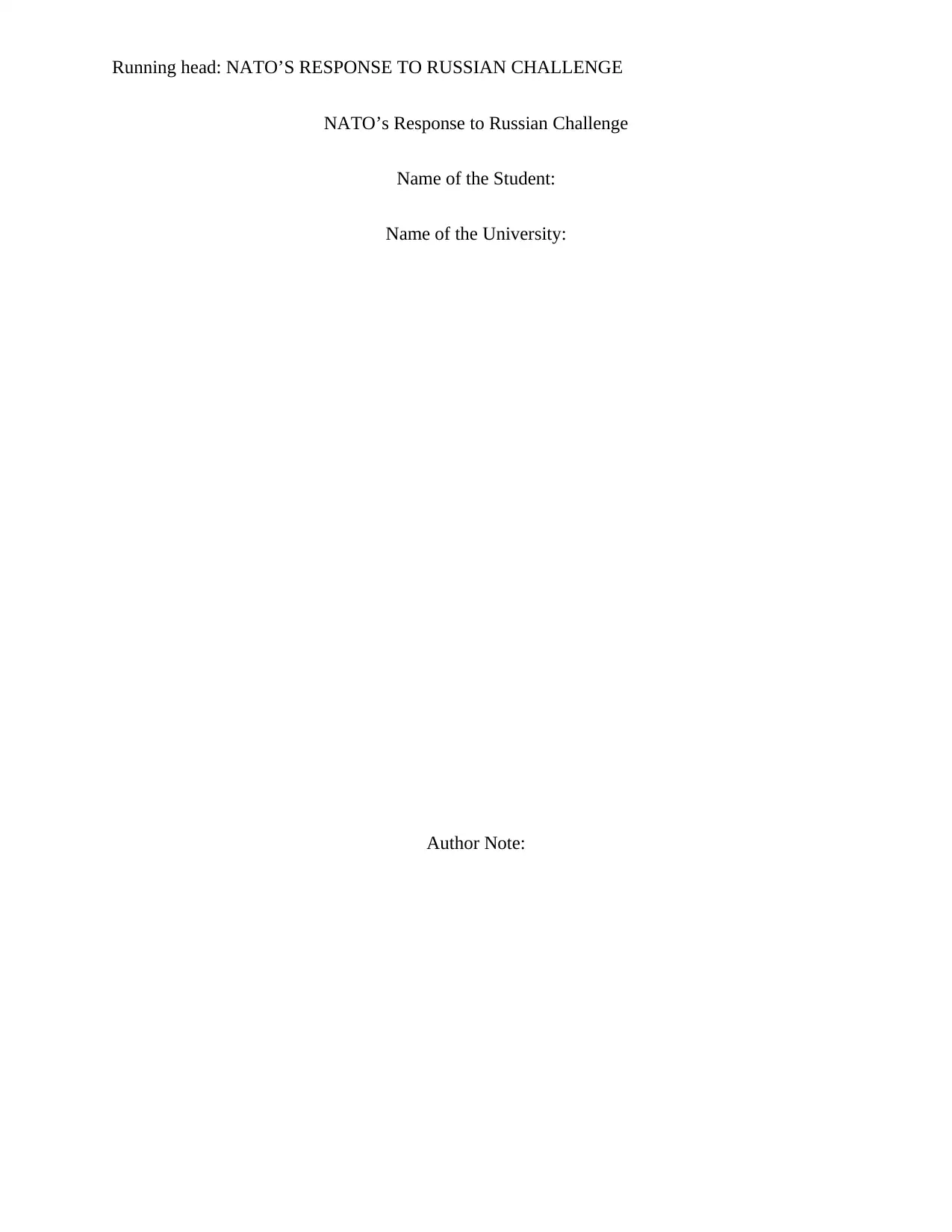
Running head: NATO’S RESPONSE TO RUSSIAN CHALLENGE
NATO’s Response to Russian Challenge
Name of the Student:
Name of the University:
Author Note:
NATO’s Response to Russian Challenge
Name of the Student:
Name of the University:
Author Note:
Secure Best Marks with AI Grader
Need help grading? Try our AI Grader for instant feedback on your assignments.
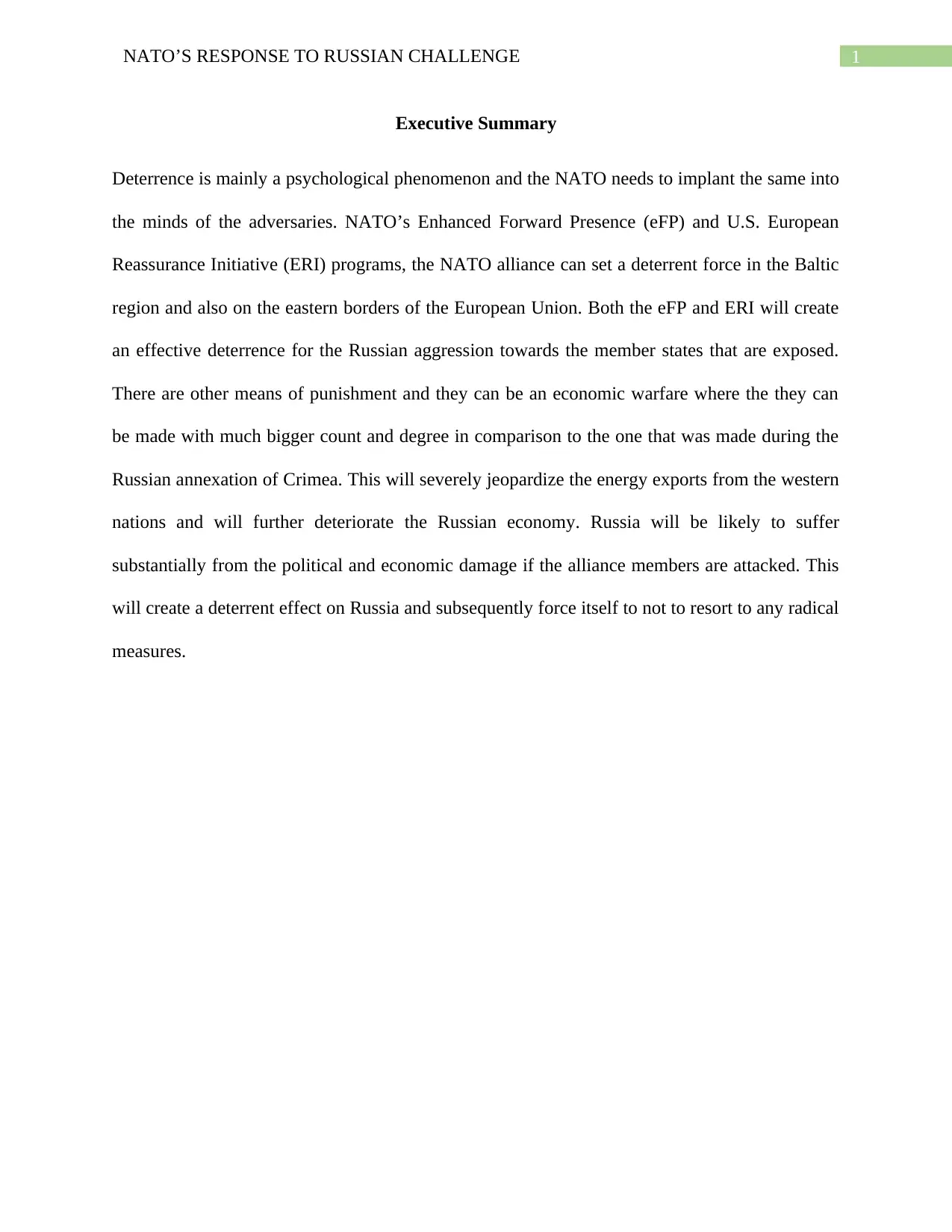
1NATO’S RESPONSE TO RUSSIAN CHALLENGE
Executive Summary
Deterrence is mainly a psychological phenomenon and the NATO needs to implant the same into
the minds of the adversaries. NATO’s Enhanced Forward Presence (eFP) and U.S. European
Reassurance Initiative (ERI) programs, the NATO alliance can set a deterrent force in the Baltic
region and also on the eastern borders of the European Union. Both the eFP and ERI will create
an effective deterrence for the Russian aggression towards the member states that are exposed.
There are other means of punishment and they can be an economic warfare where the they can
be made with much bigger count and degree in comparison to the one that was made during the
Russian annexation of Crimea. This will severely jeopardize the energy exports from the western
nations and will further deteriorate the Russian economy. Russia will be likely to suffer
substantially from the political and economic damage if the alliance members are attacked. This
will create a deterrent effect on Russia and subsequently force itself to not to resort to any radical
measures.
Executive Summary
Deterrence is mainly a psychological phenomenon and the NATO needs to implant the same into
the minds of the adversaries. NATO’s Enhanced Forward Presence (eFP) and U.S. European
Reassurance Initiative (ERI) programs, the NATO alliance can set a deterrent force in the Baltic
region and also on the eastern borders of the European Union. Both the eFP and ERI will create
an effective deterrence for the Russian aggression towards the member states that are exposed.
There are other means of punishment and they can be an economic warfare where the they can
be made with much bigger count and degree in comparison to the one that was made during the
Russian annexation of Crimea. This will severely jeopardize the energy exports from the western
nations and will further deteriorate the Russian economy. Russia will be likely to suffer
substantially from the political and economic damage if the alliance members are attacked. This
will create a deterrent effect on Russia and subsequently force itself to not to resort to any radical
measures.
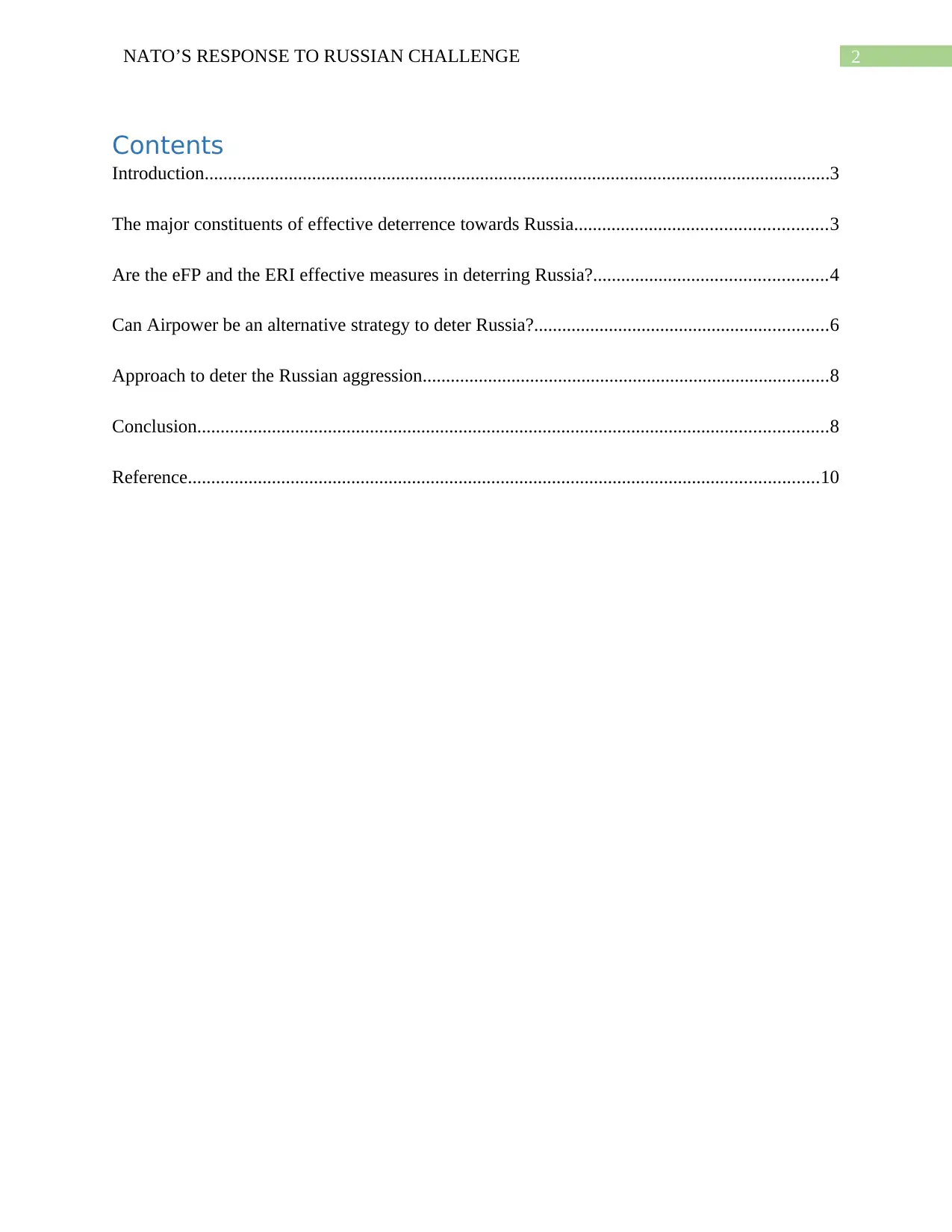
2NATO’S RESPONSE TO RUSSIAN CHALLENGE
Contents
Introduction......................................................................................................................................3
The major constituents of effective deterrence towards Russia......................................................3
Are the eFP and the ERI effective measures in deterring Russia?..................................................4
Can Airpower be an alternative strategy to deter Russia?...............................................................6
Approach to deter the Russian aggression.......................................................................................8
Conclusion.......................................................................................................................................8
Reference.......................................................................................................................................10
Contents
Introduction......................................................................................................................................3
The major constituents of effective deterrence towards Russia......................................................3
Are the eFP and the ERI effective measures in deterring Russia?..................................................4
Can Airpower be an alternative strategy to deter Russia?...............................................................6
Approach to deter the Russian aggression.......................................................................................8
Conclusion.......................................................................................................................................8
Reference.......................................................................................................................................10
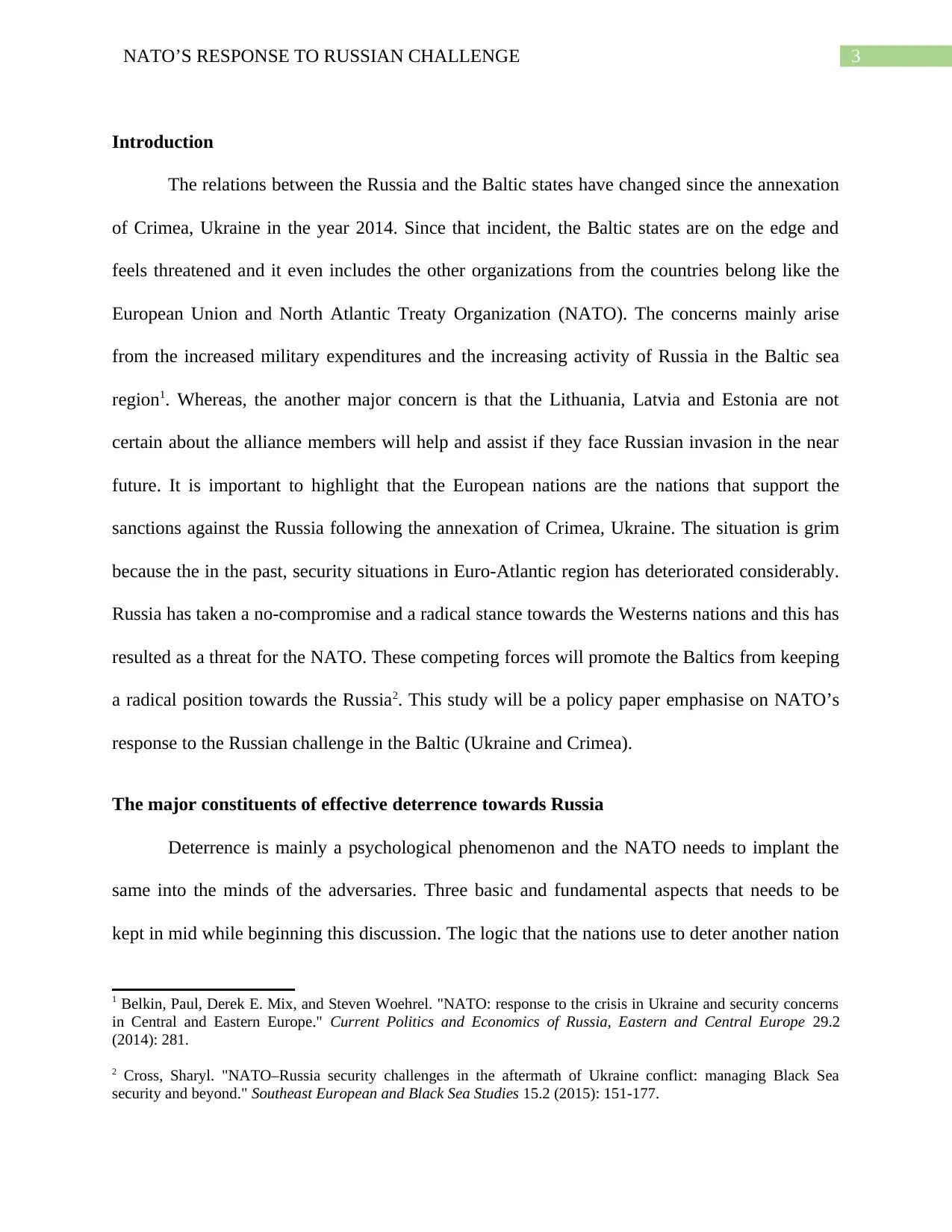
3NATO’S RESPONSE TO RUSSIAN CHALLENGE
Introduction
The relations between the Russia and the Baltic states have changed since the annexation
of Crimea, Ukraine in the year 2014. Since that incident, the Baltic states are on the edge and
feels threatened and it even includes the other organizations from the countries belong like the
European Union and North Atlantic Treaty Organization (NATO). The concerns mainly arise
from the increased military expenditures and the increasing activity of Russia in the Baltic sea
region1. Whereas, the another major concern is that the Lithuania, Latvia and Estonia are not
certain about the alliance members will help and assist if they face Russian invasion in the near
future. It is important to highlight that the European nations are the nations that support the
sanctions against the Russia following the annexation of Crimea, Ukraine. The situation is grim
because the in the past, security situations in Euro-Atlantic region has deteriorated considerably.
Russia has taken a no-compromise and a radical stance towards the Westerns nations and this has
resulted as a threat for the NATO. These competing forces will promote the Baltics from keeping
a radical position towards the Russia2. This study will be a policy paper emphasise on NATO’s
response to the Russian challenge in the Baltic (Ukraine and Crimea).
The major constituents of effective deterrence towards Russia
Deterrence is mainly a psychological phenomenon and the NATO needs to implant the
same into the minds of the adversaries. Three basic and fundamental aspects that needs to be
kept in mid while beginning this discussion. The logic that the nations use to deter another nation
1 Belkin, Paul, Derek E. Mix, and Steven Woehrel. "NATO: response to the crisis in Ukraine and security concerns
in Central and Eastern Europe." Current Politics and Economics of Russia, Eastern and Central Europe 29.2
(2014): 281.
2 Cross, Sharyl. "NATO–Russia security challenges in the aftermath of Ukraine conflict: managing Black Sea
security and beyond." Southeast European and Black Sea Studies 15.2 (2015): 151-177.
Introduction
The relations between the Russia and the Baltic states have changed since the annexation
of Crimea, Ukraine in the year 2014. Since that incident, the Baltic states are on the edge and
feels threatened and it even includes the other organizations from the countries belong like the
European Union and North Atlantic Treaty Organization (NATO). The concerns mainly arise
from the increased military expenditures and the increasing activity of Russia in the Baltic sea
region1. Whereas, the another major concern is that the Lithuania, Latvia and Estonia are not
certain about the alliance members will help and assist if they face Russian invasion in the near
future. It is important to highlight that the European nations are the nations that support the
sanctions against the Russia following the annexation of Crimea, Ukraine. The situation is grim
because the in the past, security situations in Euro-Atlantic region has deteriorated considerably.
Russia has taken a no-compromise and a radical stance towards the Westerns nations and this has
resulted as a threat for the NATO. These competing forces will promote the Baltics from keeping
a radical position towards the Russia2. This study will be a policy paper emphasise on NATO’s
response to the Russian challenge in the Baltic (Ukraine and Crimea).
The major constituents of effective deterrence towards Russia
Deterrence is mainly a psychological phenomenon and the NATO needs to implant the
same into the minds of the adversaries. Three basic and fundamental aspects that needs to be
kept in mid while beginning this discussion. The logic that the nations use to deter another nation
1 Belkin, Paul, Derek E. Mix, and Steven Woehrel. "NATO: response to the crisis in Ukraine and security concerns
in Central and Eastern Europe." Current Politics and Economics of Russia, Eastern and Central Europe 29.2
(2014): 281.
2 Cross, Sharyl. "NATO–Russia security challenges in the aftermath of Ukraine conflict: managing Black Sea
security and beyond." Southeast European and Black Sea Studies 15.2 (2015): 151-177.
Secure Best Marks with AI Grader
Need help grading? Try our AI Grader for instant feedback on your assignments.
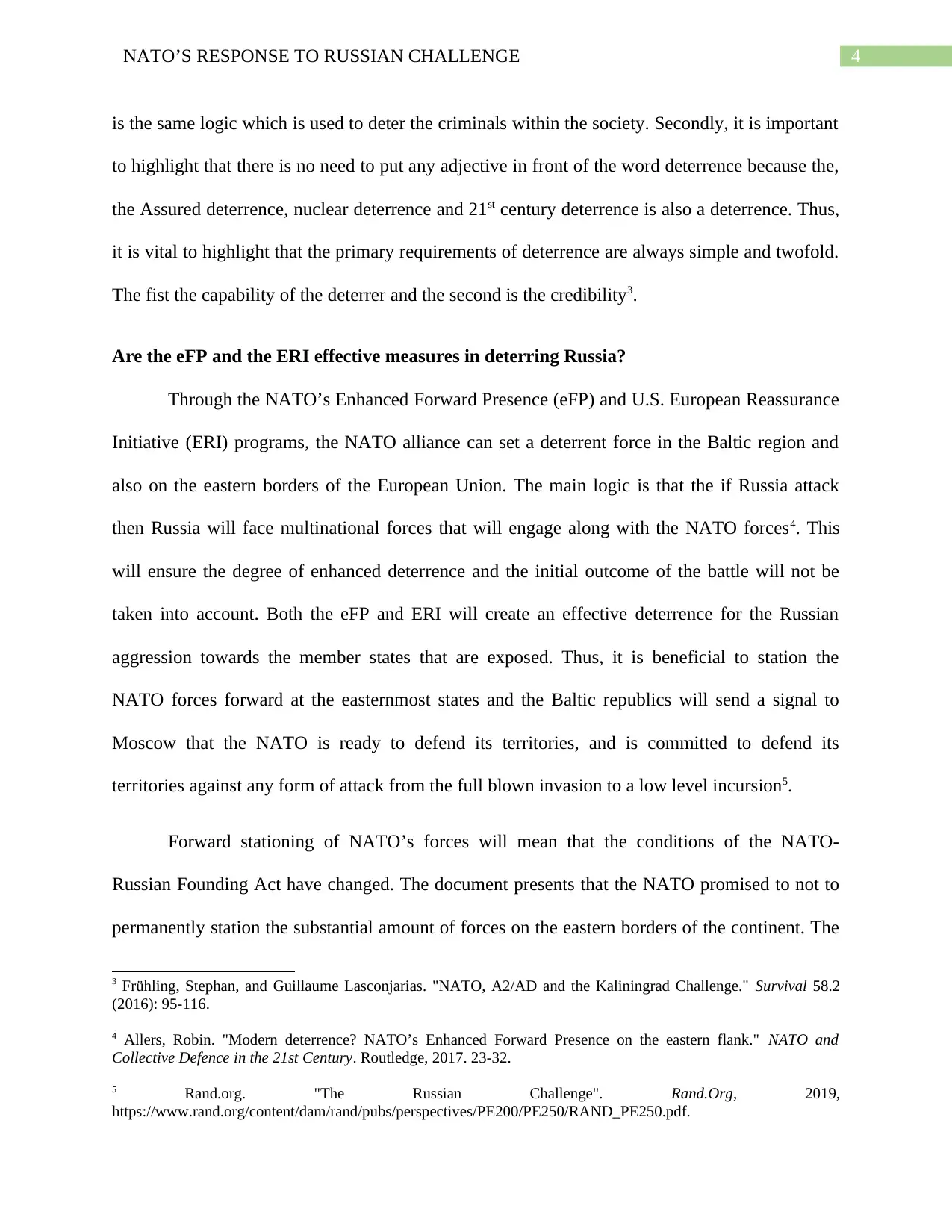
4NATO’S RESPONSE TO RUSSIAN CHALLENGE
is the same logic which is used to deter the criminals within the society. Secondly, it is important
to highlight that there is no need to put any adjective in front of the word deterrence because the,
the Assured deterrence, nuclear deterrence and 21st century deterrence is also a deterrence. Thus,
it is vital to highlight that the primary requirements of deterrence are always simple and twofold.
The fist the capability of the deterrer and the second is the credibility3.
Are the eFP and the ERI effective measures in deterring Russia?
Through the NATO’s Enhanced Forward Presence (eFP) and U.S. European Reassurance
Initiative (ERI) programs, the NATO alliance can set a deterrent force in the Baltic region and
also on the eastern borders of the European Union. The main logic is that the if Russia attack
then Russia will face multinational forces that will engage along with the NATO forces4. This
will ensure the degree of enhanced deterrence and the initial outcome of the battle will not be
taken into account. Both the eFP and ERI will create an effective deterrence for the Russian
aggression towards the member states that are exposed. Thus, it is beneficial to station the
NATO forces forward at the easternmost states and the Baltic republics will send a signal to
Moscow that the NATO is ready to defend its territories, and is committed to defend its
territories against any form of attack from the full blown invasion to a low level incursion5.
Forward stationing of NATO’s forces will mean that the conditions of the NATO-
Russian Founding Act have changed. The document presents that the NATO promised to not to
permanently station the substantial amount of forces on the eastern borders of the continent. The
3 Frühling, Stephan, and Guillaume Lasconjarias. "NATO, A2/AD and the Kaliningrad Challenge." Survival 58.2
(2016): 95-116.
4 Allers, Robin. "Modern deterrence? NATO’s Enhanced Forward Presence on the eastern flank." NATO and
Collective Defence in the 21st Century. Routledge, 2017. 23-32.
5 Rand.org. "The Russian Challenge". Rand.Org, 2019,
https://www.rand.org/content/dam/rand/pubs/perspectives/PE200/PE250/RAND_PE250.pdf.
is the same logic which is used to deter the criminals within the society. Secondly, it is important
to highlight that there is no need to put any adjective in front of the word deterrence because the,
the Assured deterrence, nuclear deterrence and 21st century deterrence is also a deterrence. Thus,
it is vital to highlight that the primary requirements of deterrence are always simple and twofold.
The fist the capability of the deterrer and the second is the credibility3.
Are the eFP and the ERI effective measures in deterring Russia?
Through the NATO’s Enhanced Forward Presence (eFP) and U.S. European Reassurance
Initiative (ERI) programs, the NATO alliance can set a deterrent force in the Baltic region and
also on the eastern borders of the European Union. The main logic is that the if Russia attack
then Russia will face multinational forces that will engage along with the NATO forces4. This
will ensure the degree of enhanced deterrence and the initial outcome of the battle will not be
taken into account. Both the eFP and ERI will create an effective deterrence for the Russian
aggression towards the member states that are exposed. Thus, it is beneficial to station the
NATO forces forward at the easternmost states and the Baltic republics will send a signal to
Moscow that the NATO is ready to defend its territories, and is committed to defend its
territories against any form of attack from the full blown invasion to a low level incursion5.
Forward stationing of NATO’s forces will mean that the conditions of the NATO-
Russian Founding Act have changed. The document presents that the NATO promised to not to
permanently station the substantial amount of forces on the eastern borders of the continent. The
3 Frühling, Stephan, and Guillaume Lasconjarias. "NATO, A2/AD and the Kaliningrad Challenge." Survival 58.2
(2016): 95-116.
4 Allers, Robin. "Modern deterrence? NATO’s Enhanced Forward Presence on the eastern flank." NATO and
Collective Defence in the 21st Century. Routledge, 2017. 23-32.
5 Rand.org. "The Russian Challenge". Rand.Org, 2019,
https://www.rand.org/content/dam/rand/pubs/perspectives/PE200/PE250/RAND_PE250.pdf.
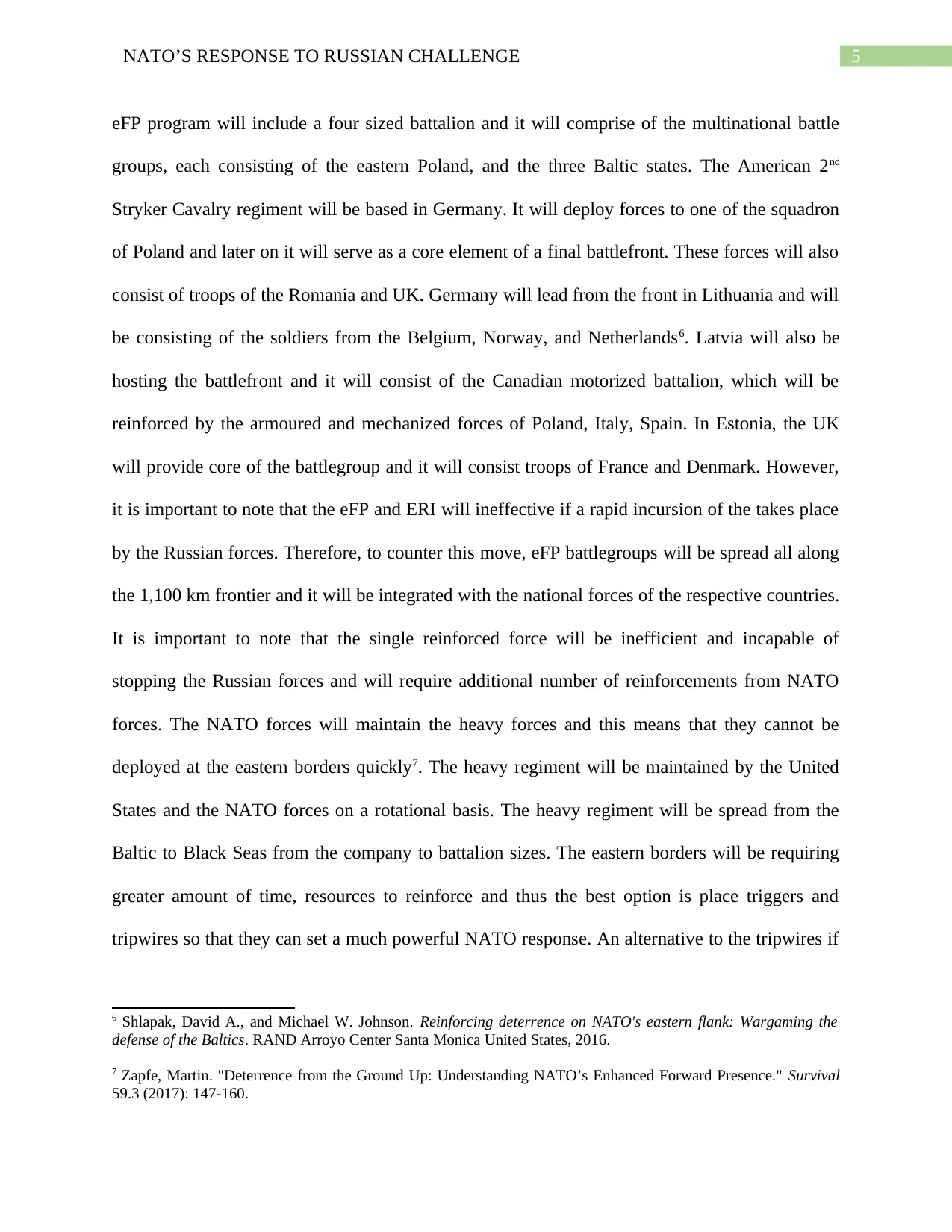
5NATO’S RESPONSE TO RUSSIAN CHALLENGE
eFP program will include a four sized battalion and it will comprise of the multinational battle
groups, each consisting of the eastern Poland, and the three Baltic states. The American 2nd
Stryker Cavalry regiment will be based in Germany. It will deploy forces to one of the squadron
of Poland and later on it will serve as a core element of a final battlefront. These forces will also
consist of troops of the Romania and UK. Germany will lead from the front in Lithuania and will
be consisting of the soldiers from the Belgium, Norway, and Netherlands6. Latvia will also be
hosting the battlefront and it will consist of the Canadian motorized battalion, which will be
reinforced by the armoured and mechanized forces of Poland, Italy, Spain. In Estonia, the UK
will provide core of the battlegroup and it will consist troops of France and Denmark. However,
it is important to note that the eFP and ERI will ineffective if a rapid incursion of the takes place
by the Russian forces. Therefore, to counter this move, eFP battlegroups will be spread all along
the 1,100 km frontier and it will be integrated with the national forces of the respective countries.
It is important to note that the single reinforced force will be inefficient and incapable of
stopping the Russian forces and will require additional number of reinforcements from NATO
forces. The NATO forces will maintain the heavy forces and this means that they cannot be
deployed at the eastern borders quickly7. The heavy regiment will be maintained by the United
States and the NATO forces on a rotational basis. The heavy regiment will be spread from the
Baltic to Black Seas from the company to battalion sizes. The eastern borders will be requiring
greater amount of time, resources to reinforce and thus the best option is place triggers and
tripwires so that they can set a much powerful NATO response. An alternative to the tripwires if
6 Shlapak, David A., and Michael W. Johnson. Reinforcing deterrence on NATO's eastern flank: Wargaming the
defense of the Baltics. RAND Arroyo Center Santa Monica United States, 2016.
7 Zapfe, Martin. "Deterrence from the Ground Up: Understanding NATO’s Enhanced Forward Presence." Survival
59.3 (2017): 147-160.
eFP program will include a four sized battalion and it will comprise of the multinational battle
groups, each consisting of the eastern Poland, and the three Baltic states. The American 2nd
Stryker Cavalry regiment will be based in Germany. It will deploy forces to one of the squadron
of Poland and later on it will serve as a core element of a final battlefront. These forces will also
consist of troops of the Romania and UK. Germany will lead from the front in Lithuania and will
be consisting of the soldiers from the Belgium, Norway, and Netherlands6. Latvia will also be
hosting the battlefront and it will consist of the Canadian motorized battalion, which will be
reinforced by the armoured and mechanized forces of Poland, Italy, Spain. In Estonia, the UK
will provide core of the battlegroup and it will consist troops of France and Denmark. However,
it is important to note that the eFP and ERI will ineffective if a rapid incursion of the takes place
by the Russian forces. Therefore, to counter this move, eFP battlegroups will be spread all along
the 1,100 km frontier and it will be integrated with the national forces of the respective countries.
It is important to note that the single reinforced force will be inefficient and incapable of
stopping the Russian forces and will require additional number of reinforcements from NATO
forces. The NATO forces will maintain the heavy forces and this means that they cannot be
deployed at the eastern borders quickly7. The heavy regiment will be maintained by the United
States and the NATO forces on a rotational basis. The heavy regiment will be spread from the
Baltic to Black Seas from the company to battalion sizes. The eastern borders will be requiring
greater amount of time, resources to reinforce and thus the best option is place triggers and
tripwires so that they can set a much powerful NATO response. An alternative to the tripwires if
6 Shlapak, David A., and Michael W. Johnson. Reinforcing deterrence on NATO's eastern flank: Wargaming the
defense of the Baltics. RAND Arroyo Center Santa Monica United States, 2016.
7 Zapfe, Martin. "Deterrence from the Ground Up: Understanding NATO’s Enhanced Forward Presence." Survival
59.3 (2017): 147-160.
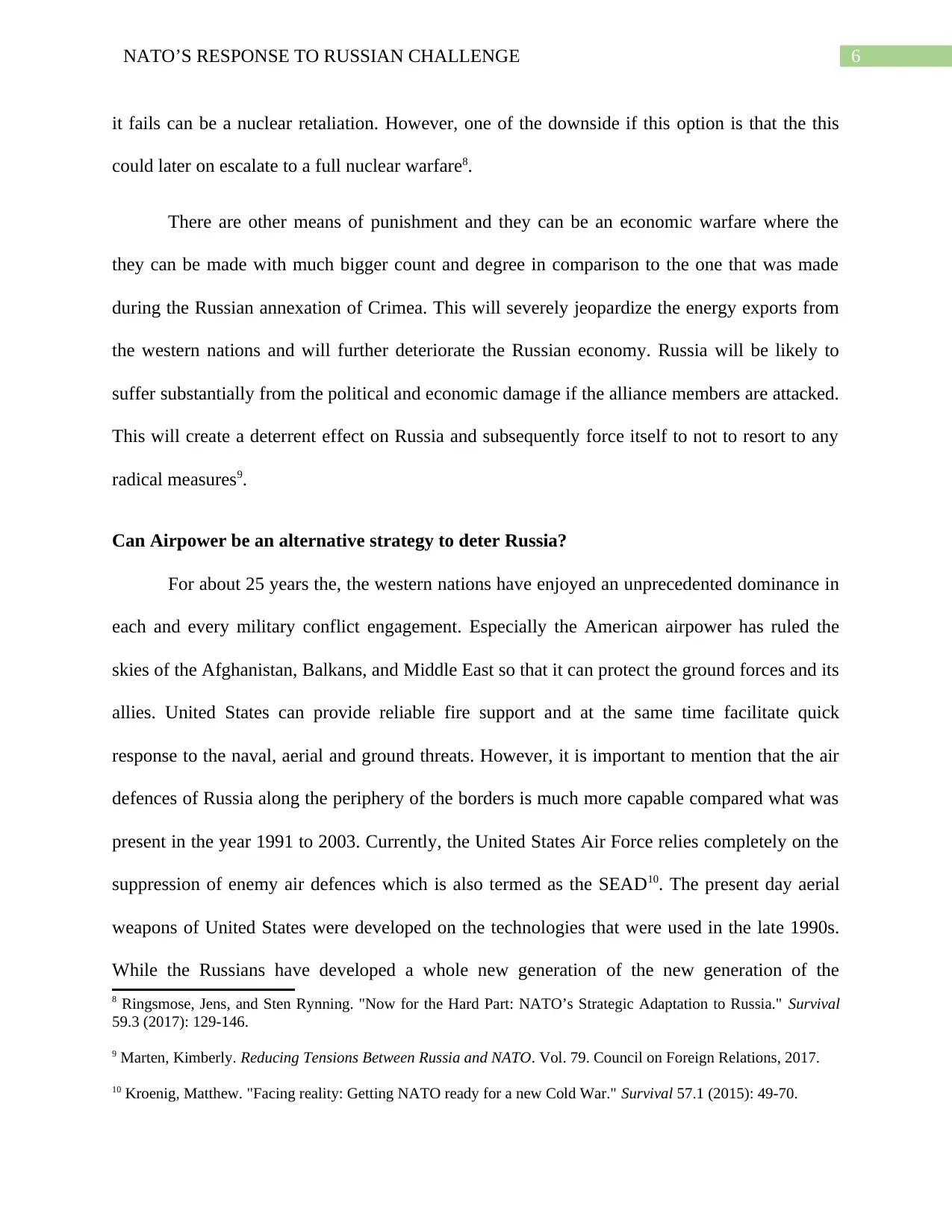
6NATO’S RESPONSE TO RUSSIAN CHALLENGE
it fails can be a nuclear retaliation. However, one of the downside if this option is that the this
could later on escalate to a full nuclear warfare8.
There are other means of punishment and they can be an economic warfare where the
they can be made with much bigger count and degree in comparison to the one that was made
during the Russian annexation of Crimea. This will severely jeopardize the energy exports from
the western nations and will further deteriorate the Russian economy. Russia will be likely to
suffer substantially from the political and economic damage if the alliance members are attacked.
This will create a deterrent effect on Russia and subsequently force itself to not to resort to any
radical measures9.
Can Airpower be an alternative strategy to deter Russia?
For about 25 years the, the western nations have enjoyed an unprecedented dominance in
each and every military conflict engagement. Especially the American airpower has ruled the
skies of the Afghanistan, Balkans, and Middle East so that it can protect the ground forces and its
allies. United States can provide reliable fire support and at the same time facilitate quick
response to the naval, aerial and ground threats. However, it is important to mention that the air
defences of Russia along the periphery of the borders is much more capable compared what was
present in the year 1991 to 2003. Currently, the United States Air Force relies completely on the
suppression of enemy air defences which is also termed as the SEAD10. The present day aerial
weapons of United States were developed on the technologies that were used in the late 1990s.
While the Russians have developed a whole new generation of the new generation of the
8 Ringsmose, Jens, and Sten Rynning. "Now for the Hard Part: NATO’s Strategic Adaptation to Russia." Survival
59.3 (2017): 129-146.
9 Marten, Kimberly. Reducing Tensions Between Russia and NATO. Vol. 79. Council on Foreign Relations, 2017.
10 Kroenig, Matthew. "Facing reality: Getting NATO ready for a new Cold War." Survival 57.1 (2015): 49-70.
it fails can be a nuclear retaliation. However, one of the downside if this option is that the this
could later on escalate to a full nuclear warfare8.
There are other means of punishment and they can be an economic warfare where the
they can be made with much bigger count and degree in comparison to the one that was made
during the Russian annexation of Crimea. This will severely jeopardize the energy exports from
the western nations and will further deteriorate the Russian economy. Russia will be likely to
suffer substantially from the political and economic damage if the alliance members are attacked.
This will create a deterrent effect on Russia and subsequently force itself to not to resort to any
radical measures9.
Can Airpower be an alternative strategy to deter Russia?
For about 25 years the, the western nations have enjoyed an unprecedented dominance in
each and every military conflict engagement. Especially the American airpower has ruled the
skies of the Afghanistan, Balkans, and Middle East so that it can protect the ground forces and its
allies. United States can provide reliable fire support and at the same time facilitate quick
response to the naval, aerial and ground threats. However, it is important to mention that the air
defences of Russia along the periphery of the borders is much more capable compared what was
present in the year 1991 to 2003. Currently, the United States Air Force relies completely on the
suppression of enemy air defences which is also termed as the SEAD10. The present day aerial
weapons of United States were developed on the technologies that were used in the late 1990s.
While the Russians have developed a whole new generation of the new generation of the
8 Ringsmose, Jens, and Sten Rynning. "Now for the Hard Part: NATO’s Strategic Adaptation to Russia." Survival
59.3 (2017): 129-146.
9 Marten, Kimberly. Reducing Tensions Between Russia and NATO. Vol. 79. Council on Foreign Relations, 2017.
10 Kroenig, Matthew. "Facing reality: Getting NATO ready for a new Cold War." Survival 57.1 (2015): 49-70.
Paraphrase This Document
Need a fresh take? Get an instant paraphrase of this document with our AI Paraphraser
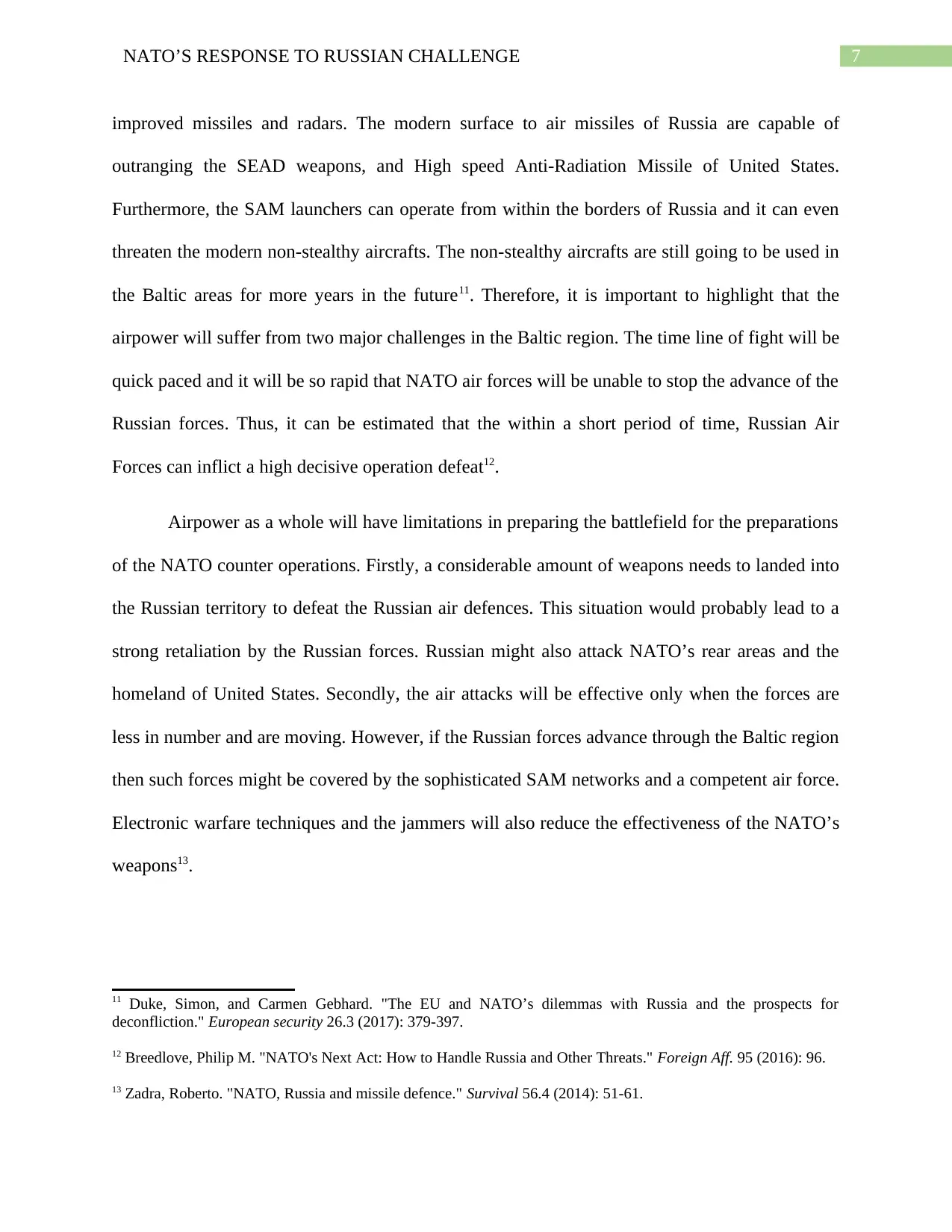
7NATO’S RESPONSE TO RUSSIAN CHALLENGE
improved missiles and radars. The modern surface to air missiles of Russia are capable of
outranging the SEAD weapons, and High speed Anti-Radiation Missile of United States.
Furthermore, the SAM launchers can operate from within the borders of Russia and it can even
threaten the modern non-stealthy aircrafts. The non-stealthy aircrafts are still going to be used in
the Baltic areas for more years in the future11. Therefore, it is important to highlight that the
airpower will suffer from two major challenges in the Baltic region. The time line of fight will be
quick paced and it will be so rapid that NATO air forces will be unable to stop the advance of the
Russian forces. Thus, it can be estimated that the within a short period of time, Russian Air
Forces can inflict a high decisive operation defeat12.
Airpower as a whole will have limitations in preparing the battlefield for the preparations
of the NATO counter operations. Firstly, a considerable amount of weapons needs to landed into
the Russian territory to defeat the Russian air defences. This situation would probably lead to a
strong retaliation by the Russian forces. Russian might also attack NATO’s rear areas and the
homeland of United States. Secondly, the air attacks will be effective only when the forces are
less in number and are moving. However, if the Russian forces advance through the Baltic region
then such forces might be covered by the sophisticated SAM networks and a competent air force.
Electronic warfare techniques and the jammers will also reduce the effectiveness of the NATO’s
weapons13.
11 Duke, Simon, and Carmen Gebhard. "The EU and NATO’s dilemmas with Russia and the prospects for
deconfliction." European security 26.3 (2017): 379-397.
12 Breedlove, Philip M. "NATO's Next Act: How to Handle Russia and Other Threats." Foreign Aff. 95 (2016): 96.
13 Zadra, Roberto. "NATO, Russia and missile defence." Survival 56.4 (2014): 51-61.
improved missiles and radars. The modern surface to air missiles of Russia are capable of
outranging the SEAD weapons, and High speed Anti-Radiation Missile of United States.
Furthermore, the SAM launchers can operate from within the borders of Russia and it can even
threaten the modern non-stealthy aircrafts. The non-stealthy aircrafts are still going to be used in
the Baltic areas for more years in the future11. Therefore, it is important to highlight that the
airpower will suffer from two major challenges in the Baltic region. The time line of fight will be
quick paced and it will be so rapid that NATO air forces will be unable to stop the advance of the
Russian forces. Thus, it can be estimated that the within a short period of time, Russian Air
Forces can inflict a high decisive operation defeat12.
Airpower as a whole will have limitations in preparing the battlefield for the preparations
of the NATO counter operations. Firstly, a considerable amount of weapons needs to landed into
the Russian territory to defeat the Russian air defences. This situation would probably lead to a
strong retaliation by the Russian forces. Russian might also attack NATO’s rear areas and the
homeland of United States. Secondly, the air attacks will be effective only when the forces are
less in number and are moving. However, if the Russian forces advance through the Baltic region
then such forces might be covered by the sophisticated SAM networks and a competent air force.
Electronic warfare techniques and the jammers will also reduce the effectiveness of the NATO’s
weapons13.
11 Duke, Simon, and Carmen Gebhard. "The EU and NATO’s dilemmas with Russia and the prospects for
deconfliction." European security 26.3 (2017): 379-397.
12 Breedlove, Philip M. "NATO's Next Act: How to Handle Russia and Other Threats." Foreign Aff. 95 (2016): 96.
13 Zadra, Roberto. "NATO, Russia and missile defence." Survival 56.4 (2014): 51-61.
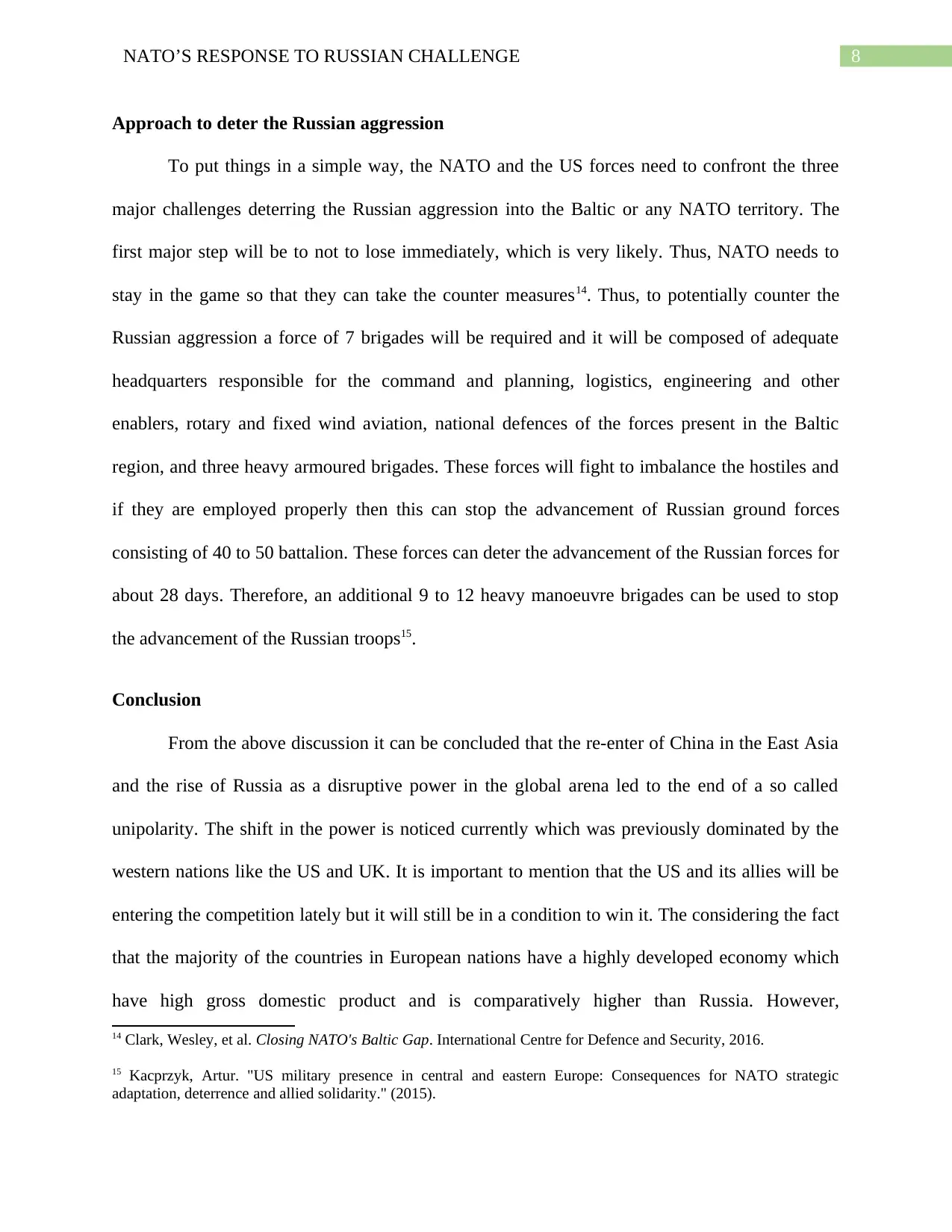
8NATO’S RESPONSE TO RUSSIAN CHALLENGE
Approach to deter the Russian aggression
To put things in a simple way, the NATO and the US forces need to confront the three
major challenges deterring the Russian aggression into the Baltic or any NATO territory. The
first major step will be to not to lose immediately, which is very likely. Thus, NATO needs to
stay in the game so that they can take the counter measures14. Thus, to potentially counter the
Russian aggression a force of 7 brigades will be required and it will be composed of adequate
headquarters responsible for the command and planning, logistics, engineering and other
enablers, rotary and fixed wind aviation, national defences of the forces present in the Baltic
region, and three heavy armoured brigades. These forces will fight to imbalance the hostiles and
if they are employed properly then this can stop the advancement of Russian ground forces
consisting of 40 to 50 battalion. These forces can deter the advancement of the Russian forces for
about 28 days. Therefore, an additional 9 to 12 heavy manoeuvre brigades can be used to stop
the advancement of the Russian troops15.
Conclusion
From the above discussion it can be concluded that the re-enter of China in the East Asia
and the rise of Russia as a disruptive power in the global arena led to the end of a so called
unipolarity. The shift in the power is noticed currently which was previously dominated by the
western nations like the US and UK. It is important to mention that the US and its allies will be
entering the competition lately but it will still be in a condition to win it. The considering the fact
that the majority of the countries in European nations have a highly developed economy which
have high gross domestic product and is comparatively higher than Russia. However,
14 Clark, Wesley, et al. Closing NATO's Baltic Gap. International Centre for Defence and Security, 2016.
15 Kacprzyk, Artur. "US military presence in central and eastern Europe: Consequences for NATO strategic
adaptation, deterrence and allied solidarity." (2015).
Approach to deter the Russian aggression
To put things in a simple way, the NATO and the US forces need to confront the three
major challenges deterring the Russian aggression into the Baltic or any NATO territory. The
first major step will be to not to lose immediately, which is very likely. Thus, NATO needs to
stay in the game so that they can take the counter measures14. Thus, to potentially counter the
Russian aggression a force of 7 brigades will be required and it will be composed of adequate
headquarters responsible for the command and planning, logistics, engineering and other
enablers, rotary and fixed wind aviation, national defences of the forces present in the Baltic
region, and three heavy armoured brigades. These forces will fight to imbalance the hostiles and
if they are employed properly then this can stop the advancement of Russian ground forces
consisting of 40 to 50 battalion. These forces can deter the advancement of the Russian forces for
about 28 days. Therefore, an additional 9 to 12 heavy manoeuvre brigades can be used to stop
the advancement of the Russian troops15.
Conclusion
From the above discussion it can be concluded that the re-enter of China in the East Asia
and the rise of Russia as a disruptive power in the global arena led to the end of a so called
unipolarity. The shift in the power is noticed currently which was previously dominated by the
western nations like the US and UK. It is important to mention that the US and its allies will be
entering the competition lately but it will still be in a condition to win it. The considering the fact
that the majority of the countries in European nations have a highly developed economy which
have high gross domestic product and is comparatively higher than Russia. However,
14 Clark, Wesley, et al. Closing NATO's Baltic Gap. International Centre for Defence and Security, 2016.
15 Kacprzyk, Artur. "US military presence in central and eastern Europe: Consequences for NATO strategic
adaptation, deterrence and allied solidarity." (2015).
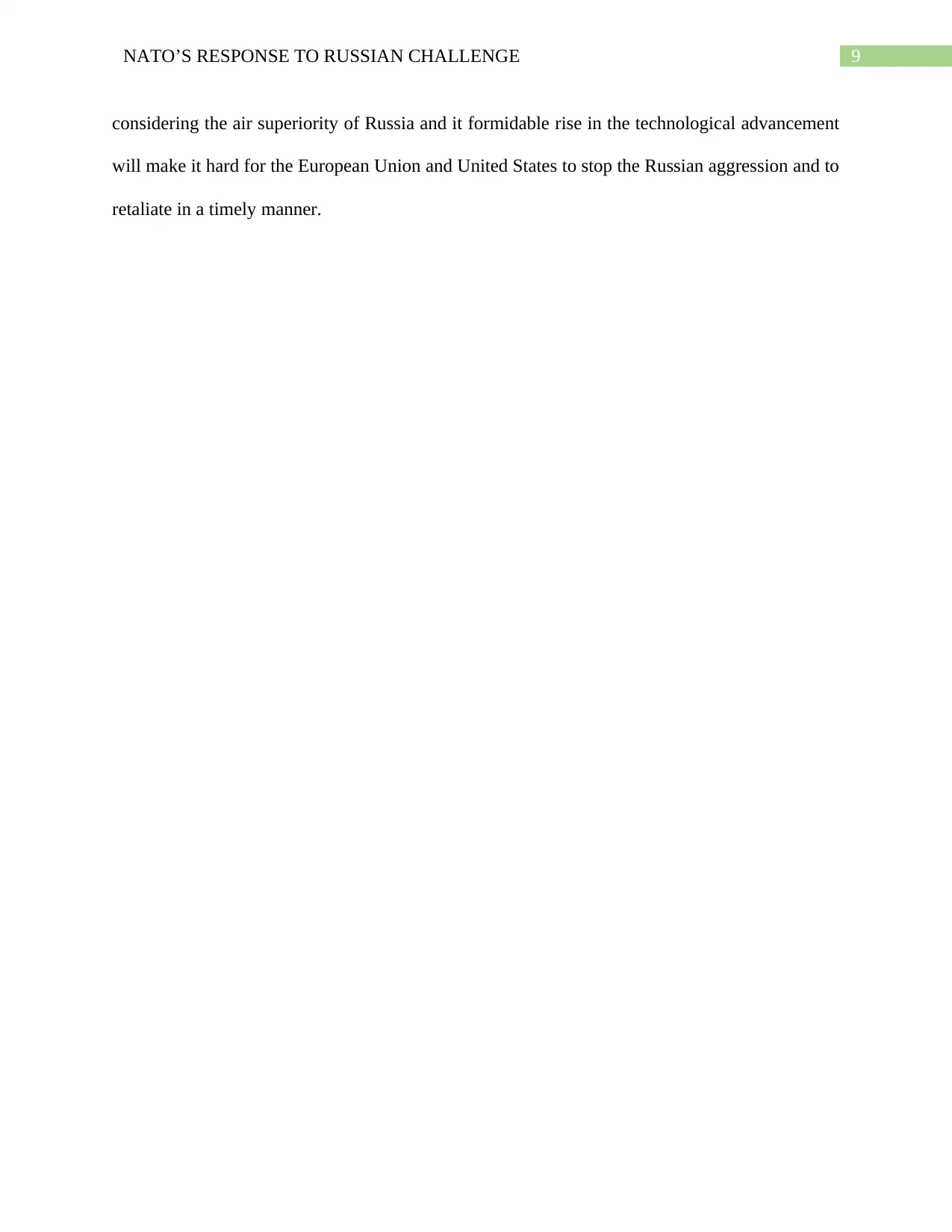
9NATO’S RESPONSE TO RUSSIAN CHALLENGE
considering the air superiority of Russia and it formidable rise in the technological advancement
will make it hard for the European Union and United States to stop the Russian aggression and to
retaliate in a timely manner.
considering the air superiority of Russia and it formidable rise in the technological advancement
will make it hard for the European Union and United States to stop the Russian aggression and to
retaliate in a timely manner.
Secure Best Marks with AI Grader
Need help grading? Try our AI Grader for instant feedback on your assignments.
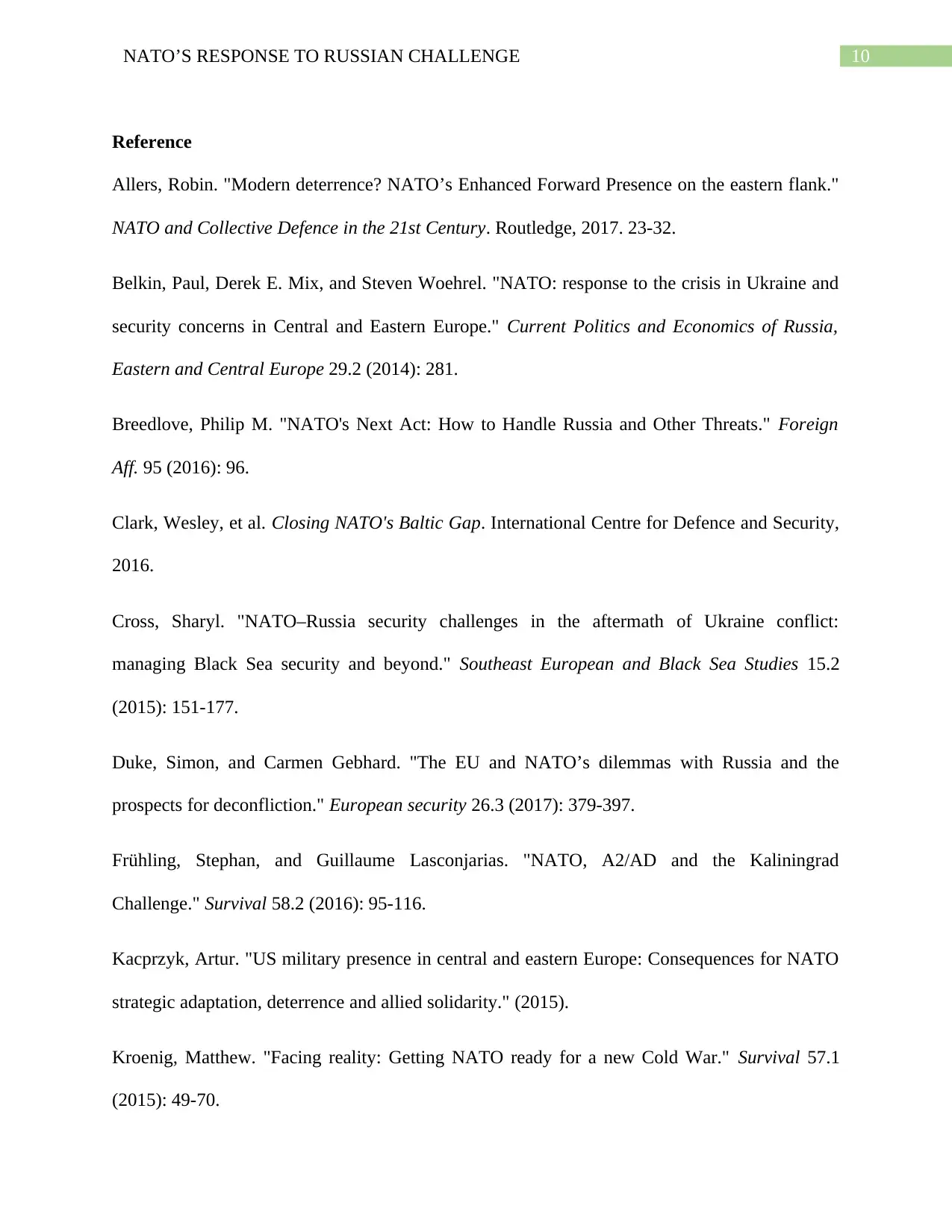
10NATO’S RESPONSE TO RUSSIAN CHALLENGE
Reference
Allers, Robin. "Modern deterrence? NATO’s Enhanced Forward Presence on the eastern flank."
NATO and Collective Defence in the 21st Century. Routledge, 2017. 23-32.
Belkin, Paul, Derek E. Mix, and Steven Woehrel. "NATO: response to the crisis in Ukraine and
security concerns in Central and Eastern Europe." Current Politics and Economics of Russia,
Eastern and Central Europe 29.2 (2014): 281.
Breedlove, Philip M. "NATO's Next Act: How to Handle Russia and Other Threats." Foreign
Aff. 95 (2016): 96.
Clark, Wesley, et al. Closing NATO's Baltic Gap. International Centre for Defence and Security,
2016.
Cross, Sharyl. "NATO–Russia security challenges in the aftermath of Ukraine conflict:
managing Black Sea security and beyond." Southeast European and Black Sea Studies 15.2
(2015): 151-177.
Duke, Simon, and Carmen Gebhard. "The EU and NATO’s dilemmas with Russia and the
prospects for deconfliction." European security 26.3 (2017): 379-397.
Frühling, Stephan, and Guillaume Lasconjarias. "NATO, A2/AD and the Kaliningrad
Challenge." Survival 58.2 (2016): 95-116.
Kacprzyk, Artur. "US military presence in central and eastern Europe: Consequences for NATO
strategic adaptation, deterrence and allied solidarity." (2015).
Kroenig, Matthew. "Facing reality: Getting NATO ready for a new Cold War." Survival 57.1
(2015): 49-70.
Reference
Allers, Robin. "Modern deterrence? NATO’s Enhanced Forward Presence on the eastern flank."
NATO and Collective Defence in the 21st Century. Routledge, 2017. 23-32.
Belkin, Paul, Derek E. Mix, and Steven Woehrel. "NATO: response to the crisis in Ukraine and
security concerns in Central and Eastern Europe." Current Politics and Economics of Russia,
Eastern and Central Europe 29.2 (2014): 281.
Breedlove, Philip M. "NATO's Next Act: How to Handle Russia and Other Threats." Foreign
Aff. 95 (2016): 96.
Clark, Wesley, et al. Closing NATO's Baltic Gap. International Centre for Defence and Security,
2016.
Cross, Sharyl. "NATO–Russia security challenges in the aftermath of Ukraine conflict:
managing Black Sea security and beyond." Southeast European and Black Sea Studies 15.2
(2015): 151-177.
Duke, Simon, and Carmen Gebhard. "The EU and NATO’s dilemmas with Russia and the
prospects for deconfliction." European security 26.3 (2017): 379-397.
Frühling, Stephan, and Guillaume Lasconjarias. "NATO, A2/AD and the Kaliningrad
Challenge." Survival 58.2 (2016): 95-116.
Kacprzyk, Artur. "US military presence in central and eastern Europe: Consequences for NATO
strategic adaptation, deterrence and allied solidarity." (2015).
Kroenig, Matthew. "Facing reality: Getting NATO ready for a new Cold War." Survival 57.1
(2015): 49-70.
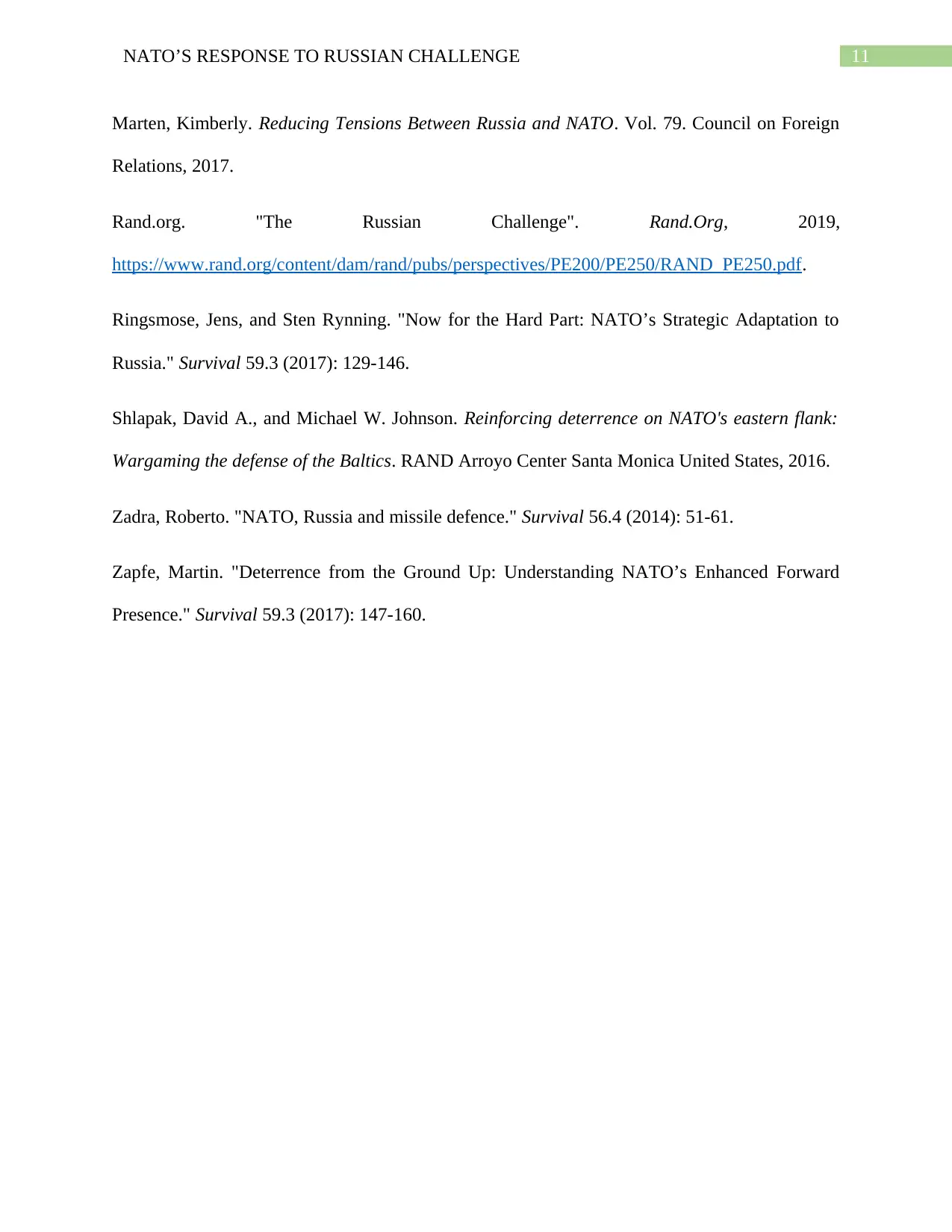
11NATO’S RESPONSE TO RUSSIAN CHALLENGE
Marten, Kimberly. Reducing Tensions Between Russia and NATO. Vol. 79. Council on Foreign
Relations, 2017.
Rand.org. "The Russian Challenge". Rand.Org, 2019,
https://www.rand.org/content/dam/rand/pubs/perspectives/PE200/PE250/RAND_PE250.pdf.
Ringsmose, Jens, and Sten Rynning. "Now for the Hard Part: NATO’s Strategic Adaptation to
Russia." Survival 59.3 (2017): 129-146.
Shlapak, David A., and Michael W. Johnson. Reinforcing deterrence on NATO's eastern flank:
Wargaming the defense of the Baltics. RAND Arroyo Center Santa Monica United States, 2016.
Zadra, Roberto. "NATO, Russia and missile defence." Survival 56.4 (2014): 51-61.
Zapfe, Martin. "Deterrence from the Ground Up: Understanding NATO’s Enhanced Forward
Presence." Survival 59.3 (2017): 147-160.
Marten, Kimberly. Reducing Tensions Between Russia and NATO. Vol. 79. Council on Foreign
Relations, 2017.
Rand.org. "The Russian Challenge". Rand.Org, 2019,
https://www.rand.org/content/dam/rand/pubs/perspectives/PE200/PE250/RAND_PE250.pdf.
Ringsmose, Jens, and Sten Rynning. "Now for the Hard Part: NATO’s Strategic Adaptation to
Russia." Survival 59.3 (2017): 129-146.
Shlapak, David A., and Michael W. Johnson. Reinforcing deterrence on NATO's eastern flank:
Wargaming the defense of the Baltics. RAND Arroyo Center Santa Monica United States, 2016.
Zadra, Roberto. "NATO, Russia and missile defence." Survival 56.4 (2014): 51-61.
Zapfe, Martin. "Deterrence from the Ground Up: Understanding NATO’s Enhanced Forward
Presence." Survival 59.3 (2017): 147-160.
1 out of 12
Your All-in-One AI-Powered Toolkit for Academic Success.
+13062052269
info@desklib.com
Available 24*7 on WhatsApp / Email
![[object Object]](/_next/static/media/star-bottom.7253800d.svg)
Unlock your academic potential
© 2024 | Zucol Services PVT LTD | All rights reserved.